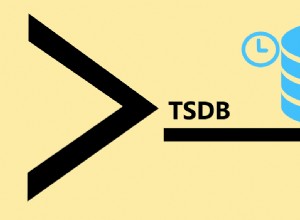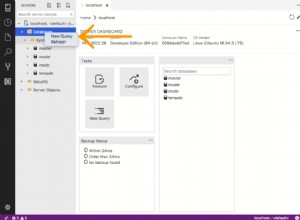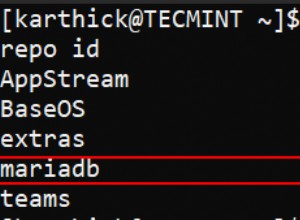Der Wert der Indizierung
PostgreSQL bietet einen einfachen linearen Abstandsoperator <-> (Luftlinie). Wir werden dies verwenden, um Punkte zu finden, die einem bestimmten Ort am nächsten liegen.
PostgreSQL stellt einen einfachen linearen Abstandsoperator für die Daten bereit, und ohne Optimierungen und ohne Indizes sehen wir den folgenden Ausführungsplan:
time psql -qtAc "
EXPLAIN (ANALYZE ON, BUFFERS ON)
SELECT name, location
FROM geonames
ORDER BY location <-> '(29.9691,-95.6972)'
LIMIT 5;
" <-- closing quote
QUERY PLAN
-----------------------------------------------------------------------------------------------------------
Limit (cost=418749.15..418749.73 rows=5 width=38)
(actual time=2553.970..2555.673 rows=5 loops=1)
Buffers: shared hit=100 read=272836
-> Gather Merge (cost=418749.15..1580358.21 rows=9955954 width=38)
(actual time=2553.969..2555.669 rows=5 loops=1)
Workers Planned: 2
Workers Launched: 2
Buffers: shared hit=100 read=272836
-> Sort (cost=417749.12..430194.06 rows=4977977 width=38)
(actual time=2548.220..2548.221 rows=4 loops=3)
Sort Key: ((location <-> '(29.9691,-95.6972)'::point))
Sort Method: top-N heapsort Memory: 25kB
Worker 0: Sort Method: top-N heapsort Memory: 26kB
Worker 1: Sort Method: top-N heapsort Memory: 25kB
Buffers: shared hit=100 read=272836
-> Parallel Seq Scan on geonames (cost=0.00..335066.71 rows=4977977 width=38)
(actual time=0.040..1637.884 rows=3982382 loops=3)
Buffers: shared hit=6 read=272836
Planning Time: 0.493 ms
Execution Time: 2555.737 ms
real 0m2.595s
user 0m0.011s
sys 0m0.015s
und hier sind die Ergebnisse:(die gleichen Ergebnisse für alle Anfragen, daher lassen wir sie später weg.)
| Name | Standort |
|---|---|
| Zypresse | (29.96911,-95.69717) |
| Cypress Pointe Baptist Church | (29,9732,-95,6873) |
| Cypress Post Office | (29.9743,-95.67953) |
| Heiße Quellen | (29.95689,-95.68189) |
| Flughafen Dry Creek | (29.98571,-95.68597) |
418749,73 sind also die OPTIMIZER-Kosten, die es zu schlagen gilt, und es dauerte zweieinhalb Sekunden (2555,673), um diese Abfrage auszuführen. Dies ist tatsächlich ein sehr gutes Ergebnis, wenn PostgreSQL ohne jegliche Optimierungen für eine Tabelle mit 11 Millionen Zeilen verwendet wird. Aus diesem Grund haben wir auch einen größeren Datensatz ausgewählt, da es nur einen sehr geringen Unterschied geben würde, wenn Indizes für weniger als 10 Millionen Zeilen verwendet würden. Parallele sequentielle Scans sind fantastisch, aber das ist ein anderer Artikel.
Hinzufügen des GiST-Index
Wir beginnen den Optimierungsprozess, indem wir einen GiST-Index hinzufügen. Da unsere Beispielabfrage ein
hatLIMIT
Klausel von 5 Artikeln haben wir eine sehr hohe Selektivität. Dies wird den Planer dazu anregen, einen Index zu verwenden, also stellen wir einen zur Verfügung, der ziemlich gut mit Geometriedaten funktioniert.
time psql -qtAc "CREATE INDEX idx_gist_geonames_location ON geonames USING gist(location);"
Das Erstellen des Indexes ist mit einigen Kosten verbunden.
CREATE INDEX
real 3m1.988s
user 0m0.011s
sys 0m0.014s
Führen Sie dann dieselbe Abfrage erneut aus.
time psql -qtAc "
EXPLAIN (ANALYZE ON, BUFFERS ON)
SELECT name, location
FROM geonames
ORDER BY location <-> '(29.9691,-95.6972)'
LIMIT 5;
"
QUERY PLAN
----------------------------------------------------------------------------------
Limit (cost=0.42..1.16 rows=5 width=38) (actual time=0.797..0.881 rows=5 loops=1)
Buffers: shared hit=5 read=15
-> Index Scan using idx_gist_geonames_location on geonames
(cost=0.42..1773715.32 rows=11947145 width=38)
(actual time=0.796..0.879 rows=5 loops=1)
Order By: (location <-> '(29.9691,-95.6972)'::point)
Buffers: shared hit=5 read=15
Planning Time: 0.768 ms
Execution Time: 0.939 ms
real 0m0.033s
user 0m0.011s
sys 0m0.013s
In diesem Fall sehen wir eine ziemlich dramatische Verbesserung. Die geschätzten Kosten der Abfrage betragen nur 1,16! Vergleichen Sie das mit den ursprünglichen Kosten der nicht optimierten Abfrage von 418749,73. Die tatsächlich benötigte Zeit betrug 0,939 Millisekunden (neun Zehntel einer Millisekunde), was den 2,5 Sekunden der ursprünglichen Abfrage entspricht. Dieses Ergebnis erforderte weniger Zeit für die Planung, eine erheblich bessere Schätzung und etwa 3 Größenordnungen weniger Laufzeit.
Mal sehen, ob wir es besser machen können.
Hinzufügen eines SP-GiST-Index
time psql -qtAc "CREATE INDEX idx_spgist_geonames_location ON geonames USING spgist(location);"
CREATE INDEX
real 1m25.205s
user 0m0.010s
sys 0m0.015s
Und dann führen wir dieselbe Abfrage erneut aus.
time psql -qtAc "
EXPLAIN (ANALYZE ON, BUFFERS ON)
SELECT name, location
FROM geonames
ORDER BY location <-> '(29.9691,-95.6972)'
LIMIT 5;
"
QUERY PLAN
-----------------------------------------------------------------------------------
Limit (cost=0.42..1.09 rows=5 width=38) (actual time=0.066..0.323 rows=5 loops=1)
Buffers: shared hit=47
-> Index Scan using idx_spgist_geonames_location on geonames
(cost=0.42..1598071.32 rows=11947145 width=38)
(actual time=0.065..0.320 rows=5 loops=1)
Order By: (location <-> '(29.9691,-95.6972)'::point)
Buffers: shared hit=47
Planning Time: 0.122 ms
Execution Time: 0.358 ms
(7 rows)
real 0m0.040s
user 0m0.011s
sys 0m0.015s
Wow! Jetzt mit einem SP-GiST-Index kostete die Abfrage nur 1,09 und wurde in 0,358 Millisekunden (einem Drittel einer Millisekunde) ausgeführt.
Lassen Sie uns einige Dinge über die Indizes selbst untersuchen und sehen, wie sie sich auf der Festplatte stapeln.
Indexvergleiche
| Indexname | Erstellungszeit | Schätzung | Abfragezeit | Indexgröße | Zeit einplanen |
|---|---|---|---|---|---|
| nicht indexiert | 0S | 418749.73 | 2555.673 | 0 | .493 |
| idx_gist_geonames_location | 3M 1S | 1.16 | 0,939 ms | 868 MB | .786 |
| idx_spgist_geonames_location | 1M 25S | 1.09 | 0,358 ms | 523 MB | .122 |
Schlussfolgerungen
Wir sehen also, dass SP-GiST in der Ausführung doppelt so schnell ist wie GiST, 8-mal schneller zu planen und etwa 60 % der Größe auf der Festplatte hat. Und (relevant für diesen Artikel) unterstützt es auch die KNN-Indexsuche ab PostgreSQL 12. Für diese Art von Operation haben wir einen klaren Gewinner.
Anhänge
Daten einrichten
Für diesen Artikel werden wir die vom GeoNames Gazetteer bereitgestellten Daten verwenden.
Dieses Werk ist unter einer Creative Commons Attribution 4.0-Lizenz lizenziert
Die Daten werden "wie besehen" ohne Gewährleistung oder Zusicherung bereitgestellt Richtigkeit, Aktualität oder Vollständigkeit.
Struktur erstellen
Wir beginnen den Prozess, indem wir ein Arbeitsverzeichnis und ein wenig ETL erstellen.
# change to our home directory
cd
mkdir spgist
cd spgist
# get the base data.
# This file is 350MB. It will unpack to 1.5GB
# It will expand to 2GB in PostgreSQL,
# and then you will still need some room for indexes
# All together, you will need about
# 3GB of space for this exercise
# for about 12M rows of data.
psql -qtAc "
CREATE TABLE IF NOT EXISTS geonames (
geonameid integer primary key
,name text
,asciiname text
,alternatenames text
,latitude numeric(13,5)
,longitude numeric(13,5)
,feature_class text
,feature_code text
,country text
,cc2 text
,admin1 text
,admin2 bigint
,admin3 bigint
,admin4 bigint
,population bigint
,elevation bigint
,dem bigint
,timezone text
,modification date );
COMMENT ON COLUMN geonames.geonameid
IS ' integer id of record in geonames database';
COMMENT ON COLUMN geonames.name
IS ' name of geographical point (utf8) varchar(200)';
COMMENT ON COLUMN geonames.asciiname
IS ' name of geographical point in plain ascii characters, varchar(200)';
COMMENT ON COLUMN geonames.alternatenames
IS ' alternatenames, comma separated, ascii names automatically transliterated,
convenience attribute from alternatename table, varchar(10000)';
COMMENT ON COLUMN geonames.latitude
IS ' latitude in decimal degrees (wgs84)';
COMMENT ON COLUMN geonames.longitude
IS ' longitude in decimal degrees (wgs84)';
COMMENT ON COLUMN geonames.feature_class
IS ' http://www.geonames.org/export/codes.html, char(1)';
COMMENT ON COLUMN geonames.feature_code
IS ' http://www.geonames.org/export/codes.html, varchar(10)';
COMMENT ON COLUMN geonames.country
IS ' ISO-3166 2-letter country code, 2 characters';
COMMENT ON COLUMN geonames.cc2
IS ' alternate country codes, comma separated, ISO-3166 2-letter country code,
200 characters';
COMMENT ON COLUMN geonames.admin1
IS ' fipscode (subject to change to iso code), see exceptions below,
see file admin1Codes.txt for display names of this code; varchar(20)';
COMMENT ON COLUMN geonames.admin2
IS ' code for the second administrative division, a county in the US,
see file admin2Codes.txt; varchar(80) ';
COMMENT ON COLUMN geonames.admin3
IS ' code for third level administrative division, varchar(20)';
COMMENT ON COLUMN geonames.admin4
IS ' code for fourth level administrative division, varchar(20)';
COMMENT ON COLUMN geonames.population
IS ' bigint (8 byte int) ';
COMMENT ON COLUMN geonames.elevation
IS ' in meters, integer';
COMMENT ON COLUMN geonames.dem
IS ' digital elevation model, srtm3 or gtopo30, average elevation of 3''x3''
(ca 90mx90m) or 30''x30'' (ca 900mx900m) area in meters, integer.
srtm processed by cgiar/ciat.';
COMMENT ON COLUMN geonames.timezone
IS ' the iana timezone id (see file timeZone.txt) varchar(40)';
COMMENT ON COLUMN geonames.modification
IS ' date of last modification in yyyy-MM-dd format';
" #<-- Don't forget the closing quote
ETL
wget http://download.geonames.org/export/dump/allCountries.zip
unzip allCountries.zip
# do this, and go get a coffee. This took nearly an hour
# there will be a few lines that fail, they don't really matter much
IFS=$'\n'
for line in $(<allCountries.txt)
do
echo -n "$line" |
psql -qtAc
"COPY geonames FROM STDIN WITH CSV DELIMITER E'\t';"
2> errors.txt
done
Aufräumen und einrichten
Alles andere machen wir innerhalb von psql:
psql
-- This command requires the installation
-- of postgis2 from your OS package manager.
-- For OS/X that was `port install postgresql12-postgis2`
-- it will be something similar on most platforms.
-- (e.g. apt-get install postgresql12-postgis2,
-- yum -y install postgresql12-postgis2, etc.)
CREATE EXTENSION postgis;
CREATE EXTENSION postgis_topology;
ALTER TABLE geonames ADD COLUMN location point;
-- Go get another cup of coffee, this is going to rewrite the entire table with the new geo column.
UPDATE geonames SET location = ('(' || latitude || ', ' || longitude || ')')::point;
DELETE FROM geonames WHERE latitude IS NULL or longitude IS NULL;
-- DELETE 32 -- In my case, this ETL anomoly was too small
-- to bother fixing the records
-- Bloat removal from the update and delete operations
CLUSTER geonames USING geonames_pkey;




